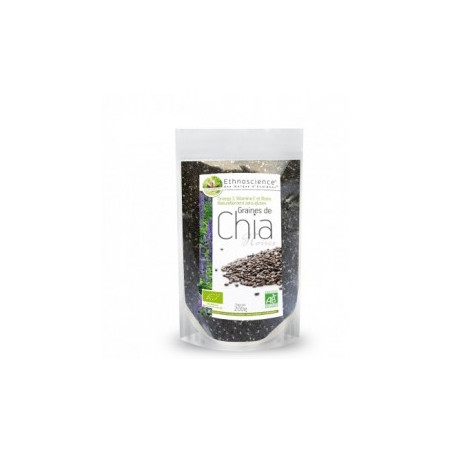








Chia (Salvia hispanica) is a species of sage native to Mexico and Guatemala that gave its name to the Mexican state of Chiapas (chia waters/river). This plant was cultivated by the Aztecs and the Mayans who already knew the particularities of this plant. Chia seeds then constituted the third plant food source in their diet after corn and bean varieties. The Chumash, Native Americans who lived in southern California before the arrival of Christopher Columbus, are said to have consumed chia seeds to improve their physical performance. The Tarahumaras, a people living in northern Mexico, in the state of Chihuahua, known to be proven long-distance runners, have the recipe for a food that makes them slender, strong and tireless,
Chia seeds are rich in essential omega-3 fatty acids (15-17% in the form of alpha-linolenic acid - ALA). 5 g of chia seed covers 45% of the RJ (daily nutritional benchmarks) in omega-3. They have a high dietary fiber content which gives them great satiating power once hydrated. Indeed, their richness in mucilage causes them to increase considerably in volume, to form a gel, when soaked in water. Chia seeds are excellent for athletes due to the proteins they contain (around 22 g per 100 g). Finally, chia seeds are gluten-free and cholesterol-free.
Excellent in pudding, by swelling the seeds the day before in vegetable milk or coconut milk. Add some spices as desired (powdered cardamom, cinnamon, etc.), coconut sugar, pieces of banana, pear or mango.
Ingredients: Black Chia Seeds (Salvia Hispnica L.)
Nutritional information: Per 100g, Calories 250kcal/1046.7kJ, Fat 32g - including saturated fatty acids 3g, Total carbohydrates 38g, Dietary fiber 35g - including soluble fiber 4g, Protein 20g, Salt 0.03g, Potassium 500mg, Calcium 500mg, Magnesium 290mg, Iron 8mg, Zinc 5mg, Phosphorus 535mg, Vitamin B1 - Thiamine 0.9mg, Vitamin B2 - Riboflavin 0.24mg, Vitamin B3 - Niacin 11mg, Vitamin E 30mg, Omega 3 20g, Omega 6 8g
Capacity: 200g bag
Chia (Salvia hispanica) is a species of sage native to Mexico and Guatemala that gave its name to the Mexican state of Chiapas (chia waters/river). This plant was cultivated by the Aztecs and the Mayans who already knew the particularities of this plant. Chia seeds then constituted the third plant food source in their diet after corn and bean varieties. The Chumash, Native Americans who lived in southern California before the arrival of Christopher Columbus, are said to have consumed chia seeds to improve their physical performance. The Tarahumaras, a people living in northern Mexico, in the state of Chihuahua, known to be proven long-distance runners, have the recipe for a food that makes them slender, strong and tireless,
Chia seeds are rich in essential omega-3 fatty acids (15-17% in the form of alpha-linolenic acid - ALA). 5 g of chia seed covers 45% of the RJ (daily nutritional benchmarks) in omega-3. They have a high dietary fiber content which gives them great satiating power once hydrated. Indeed, their richness in mucilage causes them to increase considerably in volume, to form a gel, when soaked in water. Chia seeds are excellent for athletes due to the proteins they contain (around 22 g per 100 g). Finally, chia seeds are gluten-free and cholesterol-free.
Excellent in pudding, by swelling the seeds the day before in vegetable milk or coconut milk. Add some spices as desired (powdered cardamom, cinnamon, etc.), coconut sugar, pieces of banana, pear or mango.
Ingredients: Black Chia Seeds (Salvia Hispnica L.)
Nutritional information: Per 100g, Calories 250kcal/1046.7kJ, Fat 32g - including saturated fatty acids 3g, Total carbohydrates 38g, Dietary fiber 35g - including soluble fiber 4g, Protein 20g, Salt 0.03g, Potassium 500mg, Calcium 500mg, Magnesium 290mg, Iron 8mg, Zinc 5mg, Phosphorus 535mg, Vitamin B1 - Thiamine 0.9mg, Vitamin B2 - Riboflavin 0.24mg, Vitamin B3 - Niacin 11mg, Vitamin E 30mg, Omega 3 20g, Omega 6 8g
Capacity: 200g bag
cutom text for description in ETS. Change that in traduction of the module !